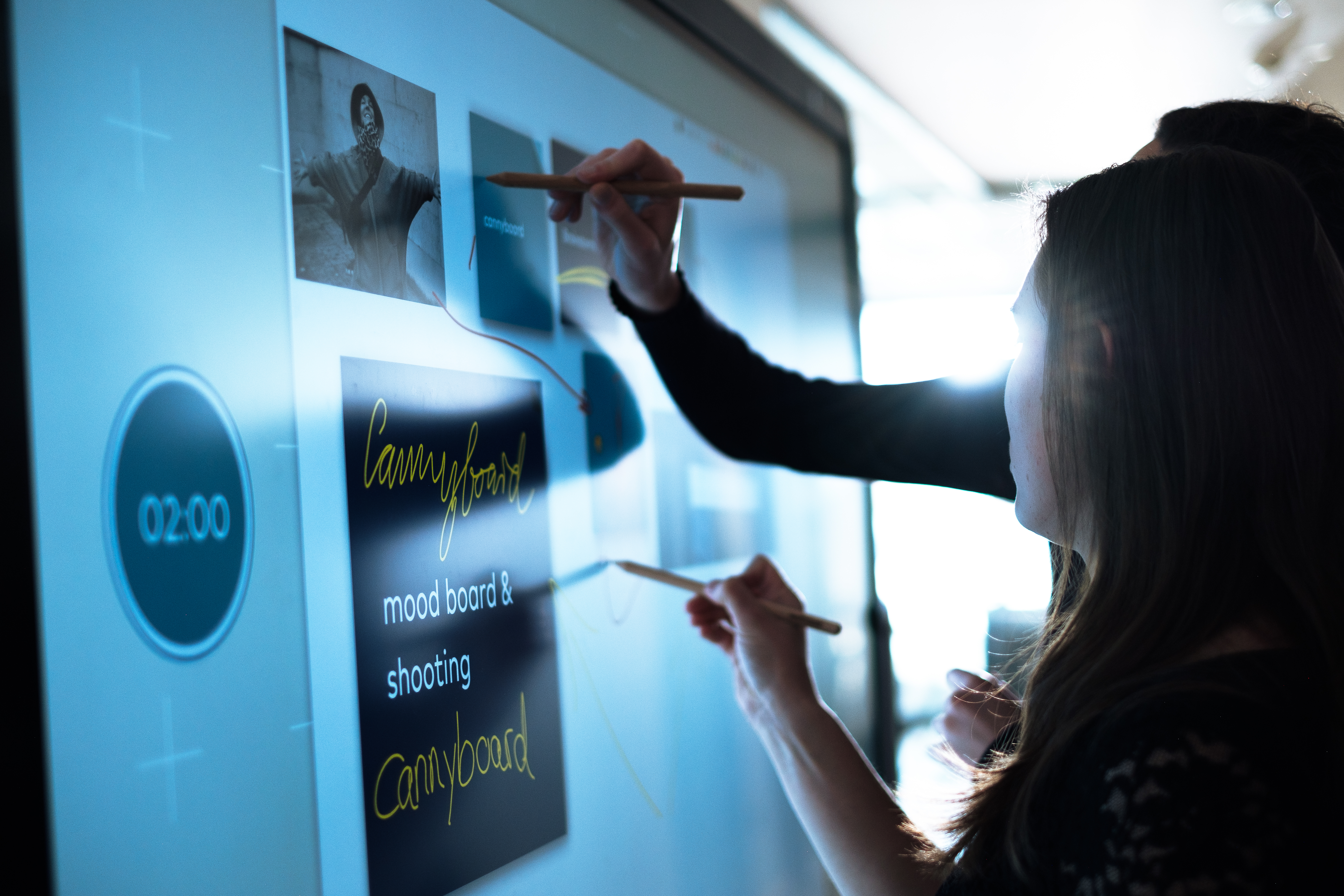Fill form to unlock content
Error - something went wrong!
Your content is just a step away. Please submit below.
Thank you!
Seamless Digital Collaboration with Smart Boards

Imagine a traditional brainstorming session with a whiteboard. One person writes down ideas on the board as the rest of the team members strategize. A separate individual might take notes to share at the end of the meeting.
The takeaways everyone remembers (and forgets) days later depend on the efficiency of the note-taker. The process becomes even more complicated when colleagues dial in remotely. Most cannot see the whiteboard clearly or hear individual contributions.
Digital collaborations can be effective only when all participants are on the same page, quite literally. A smooth brainstorming session in the hybrid work era needs a fully integrated hardware and software platform so everyone can collaborate easily.
Through an app, people can draw, annotate, and manipulate content directly on the 86-inch touchscreen. The benefit is the tactile nature of the #interactive display. TQ-Group via @insightdottech
Seamless Smart Board Platform
The cannyboard solution, a product developed by TQ-Group, is the comprehensive solution organizations need. A touchscreen smart board display functions as the primary collaborative tool. It leverages a device that practically every participant has: a mobile device. Through an app, people can draw, annotate, and manipulate content directly on the 86-inch touchscreen. The benefit is the tactile nature of the interactive display (Figure 1).

They also can share their screens wirelessly, allowing them to contribute to the session without being tethered to the board.
“Such flexibility is vital in collaborative settings where multiple participants need to share content quickly and effortlessly,” says Sofie Bauer, Head of cannyboard at TQ, a German technology solutions provider.
In addition, the option to connect PCs via HDMI and USB expands the functionality of the cannyboard. “It not only allows users to share their screen but also to control their device from the cannyboard—effectively turning it into an extension of their own device,” Bauer says. The cannyboard stores sessions in the cloud so authorized members can always access the latest work from anywhere.
Digital Collaboration Use Cases
The cannyboard supports applications in pretty much every environment that requires team members working together. The solution facilitates collaboration in a variety of spaces. This includes corporate meeting rooms, conference halls, hotels, training centers, shared office spaces, educational institutions, creative agencies, showrooms, trade fairs, exhibitions, and retail areas.
A smart board can be especially useful in sports and entertainment. The professional volleyball players of TSV Herrsching, for example, use the cannyboard for game preparation. The cannyboard integrates all the tools needed for meetings, analyses, and strategy development, whether participants are in the same room or connecting remotely.
Thomas Ranner, Head Coach of the WWK Volleys, says video analysis through the cannyboard has been instrumental for game prep. Before adopting the cannyboard, the team had to find a location where the lighting was right so that everyone could see the projector well. Video analysis required a whiteboard (for scribbling tactical ideas), a laptop, and a device for each player to display game plans.
“That is too many devices to carry around and it causes the players’ attention to shift back and forth between them. It was quite cumbersome,” says Max Hauser, team CEO and coach.
Today team meetings are completely different. “We don’t have to constantly switch between different devices for video, game plan, and whiteboard, but can run and edit everything in parallel, which makes our meetings much easier,” Hauser says. The cannyboard replaces the projector, laptop, and whiteboard in one device. While the game video plays on the board, teammates can draw or annotate directly on the video or screen and take screenshots at the same time.
The Technology Behind Interactive Displays
cannyboard ensures each session is independent and that no data persists beyond the session’s duration. “By implementing automatic data deletion, temporary storage, and session isolation, cannyboard protects user data and maintains privacy, giving users confidence that their information is secure every time they use the system,” TQ says.
The solution is based on the latest Intel® Core™ Processors, ensuring “amazing user experience through high computing power and excellent graphics,” Bauer says. Intel wireless technology provides high-speed integration in Wi-Fi infrastructure and supports Bluetooth for easy connection of external devices like wireless keyboards. And high-power efficiency through Intel performance hybrid architecture reduces overall power consumption and operating costs.
The Future of Digital Collaboration
Digital collaboration will become an essential factor in enhancing speed and efficiency in daily work, Bauer predicts.
Especially when working with members in different countries and time zones, digital collaboration saves an immense amount of time otherwise spent traveling. It also reduces confusion by bringing interactions on one screen. “The efficiency gained allows us all time for breaks, quality time with family and friends, which are vital in our fast-paced world,” Bauer says.
But despite its promises, embracing digital collaboration requires an organizational culture that fosters openness and flexibility. Increasing use of data-intensive applications will require high-speed, reliable bandwidth, and superior audio, sound and video quality. “In addition, we need seamless integration with existing systems to maximize the return on investment in new technologies,” Bauer says. Avatars, virtual reality, simultaneous translation, gesture recognition, and voice commands soon will be part of collaboration tools.
Advancements in 5G, edge computing, cloud technologies, and AI will shape the future of collaboration. For now, collaborators everywhere can be relieved that the days of basic whiteboard brainstorms might well be in the past.
This article was edited by Georganne Benesch, Editorial Director for insight.tech.